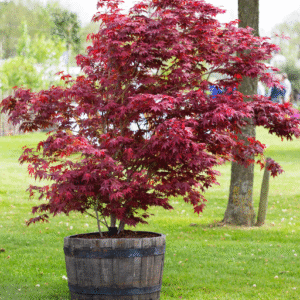Since we have so little garden space, growing a tree in a container or pot is the only way to enjoy the beauty and benefits of greenery. One can either grow fresh fruits or simply use the trees and plants for beautification of the patio or just bring a little piece of nature into urban life. This blog will take you through some of the best dwarf fruit trees suitable for containers, and some other trees thrive in pots containers. This guide takes you through things to consider when choosing varieties, as well as tips on caring for and maintaining them to help you convert a small space into a lush and thriving oasis.
Introduction to Growing Trees in Containers
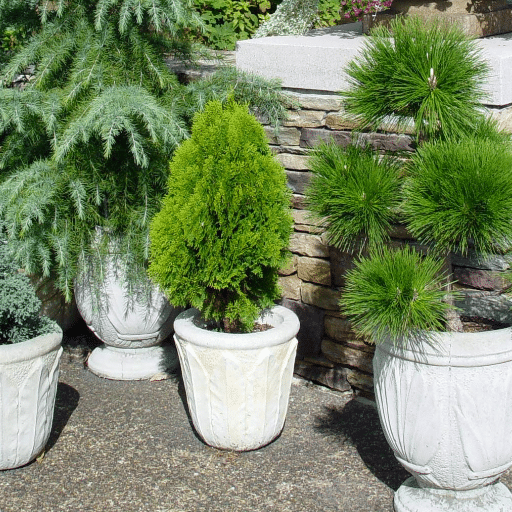
Trees thrive in pots containers is a flexible and fulfilling way to add a green touch to small spaces, be it when you stay in an apartment, have a small yard, or want to incorporate conveniences into gardening. When given the right conditions, whatever dwarf fruit or ornamental species you choose, star container trees, able to do great in an environment consisting of a well-draining potting mix, adequate sunlight, and correct watering. Choosing the right container for planting is most important, big enough to accommodate healthy root growth, and with drainage holes to avoid waterlogging. Pruning, feeding, and repotting form necessary to keep your tree healthy and fruitful. Well-cared-for and well-maintained containers could turn patios, rooftops, or balconies into lush green spaces.
Benefits of Container Gardening
Container gardening boasts a long list of benefits, making it a desirable choice for gardeners of all levels. The first benefit is that it offers flexibility and mobility, as one can easily move their plants for the best sunlight or protection from harsh weather or just to redesign their space. Then again, it is just right for those with limited outdoor space- an urban-area patio, a tiny balcony, or an enormous windowsill! Container gardening also aids in pest and weed control, as plants are placed farther from pests, along with any other problems that could attack ground-based plants. Finally, container gardening is an eco-friendly and easy way to nurture any plants from vegetables and herbs to flowers and fruit trees, growing productive gardens in a variety of colors.
Choosing the Right Pot for Your Trees
In choosing pots for the trees, several considerations are taken to promote the health and growth of the trees. The first consideration is the size of the pot: choose a container that is large enough to accommodate the tree’s root system with some room to grow, usually twice of the root ball size. There must be drainage holes in the pot to let the excess water drain out. Retaining too much water in a pot may rot the roots of plants.
The area to be considered is that of potting materials. Terracotta pots are rather porous and are suitable for some plants, but they tend to lose moisture rather quickly. Plastic pots are heavier and hold moisture better. They are also easier to move around. Another consideration will be the concept of durability: if your tree will remain outdoors throughout the year, then it will be better that you choose some sturdy materials like ceramic or concrete, whereas resin or fiberglass pots can provide excellent weather resistance and are far from heavy. Finishing up by choosing the pot style that suits the plant and space; for example, tall slender pots will emphasize a tree’s vertical lines, while wider pots will suit smaller or spreading trees. Selecting a pot that balances both function and aesthetics creates a win-win situation for me and my trees.
Understanding Dwarf Trees
Dwarf trees are unique in that they remain compact while retaining the characteristics of their full-sized counterparts. I find that these trees are ideal for small spaces or container gardening, as their smaller size makes them easy to manage and maintain. They typically reach a mature height of 8 to 10 feet, though this varies depending on species and growing conditions. I make sure to choose dwarf varieties that are well-suited to my climate and soil to ensure healthy growth. Regular pruning helps maintain their shape and encourages fruit production in fruit-bearing species. By understanding their specific needs and limitations, I can enjoy the beauty and functionality of dwarf trees in my space.
Best Trees for Pots and Containers
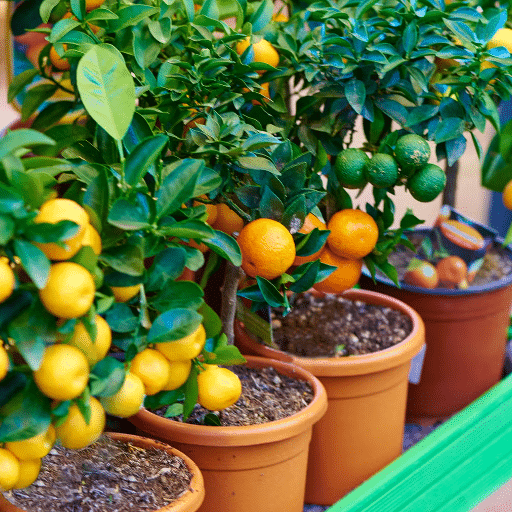
Before any tree gets planted into a pot or bucket, keep in mind that compact and slow-growing ones are best due to space constraints. Olive Trees, Japanese Maples, Citrus Trees, and Dwarf Conifers are wonderful choices as they are adaptable and visually attractive. The bucket or container should be well-draining; one must add soil that supports nutrients and water adequately. Remember, the tree must be appropriate for the region, away from stress due to seasonal temperatures. If you keep these things in mind, you will end up with a flourishing container garden that one can easily care for.
Dwarf Fruit Trees: A Perfect Choice
Growing dwarf fruit trees is an excellent choice to enjoy fresh produce even in a little space. These trees seem to require less maintenance than their full-sized counterparts but yield fruits in plenty. They can easily be grown in the ground or containers, giving them an edge over any garden arrangement. Sunlight and soil must be taken care of, as most dwarf varieties do best under full sun and are easy to drain, i.e., nutrient-rich soil. When selecting your tree, I always consider your local climate and the care requirements of the fruit variety to ensure it grows healthy and with productive harvests. There is so much fresh fruit at stake when you pick the exact dwarf fruit tree for your area and space!
Popular Dwarf Trees for Home Gardens
A few dwarf fruit trees truly earn the accolade of adaptability and producing power in home garden settings. First, dwarf citrus trees, among them Meyer lemons and key limes, enjoy year-round popularity and shower of good scent. These trees like sun and can be grown in pots, so they are perfect for patios and tiny backyard spaces.
Second, dwarf apples are a top pick because they reliably produce tasty, crisp fruit. They grow in full sun well but thrive better with well-drained soil, requiring little pruning to maintain their stature and health.
Finally, maybe you could think about another set of dwarf trees for sweetness in their summer stage: dwarf peach or nectarine! These dwarf trees are wonderful for tight spaces, as a smaller size does not affect their ability to produce juicy, flavorful fruit. With good care and attention to their specific needs, these dwarf trees will be an asset to any garden.
Considerations for Full Sun vs. Shade
When choosing full sun versus shade, it is essential to understand the light needs of the plant and how your garden environment will support those needs. The plants in full sun, like tomatoes or lavender, require at least six to eight hours of direct sunlight to thrive. On the contrary, shade plants like hostas or ferns require indirect or dappled sunlight to be good specimens. I observe the sunlight pattern in my own garden to cater to the plant’s needs before planting anything; this elevation helps plants grow healthy and strong, minimizing the stress placed onto them. On the other hand, soil quality and watering approaches influence the success in the chosen light setup, so great attention is given on them, as well.
Specific Types of Trees to Grow in Containers

Choosing trees to grow in containers requires first selecting dwarf or slow-growing varieties that can withstand limited root space. Small fruiting trees such as citrus (lemons, limes, or oranges) are great options as they are easy to manage in the small space of a container and do produce fruits. Japanese maples are another option of preference as their graceful habit and colorful leaves make them suitable for patios or shaded areas. Olive trees have wide adaptability and provide good Mediterranean aesthetics, while hardy conifers like dwarf Alberta spruce will ensure greenery all year round. Make sure the container is well-drained and use a good-quality potting mixture to promote good growth regardless of what is planted.
Dwarf Alberta Spruce
Being compact and slow-growing in its nature, the Dwarf Alberta Spruce fits perfectly into small spaces or even in containers for gardening. Its dense conical form and bright green needles make it an ideal low-maintenance option for landscapes in skillful hands. This tree does best in well-draining soil with full to partial sunlight. Keep it watered, especially during dry spells, but be careful not to overwater since doing so may cause root rot. Besides that, this hardy conifer is cold hardy, thriving well in USDA hardiness zones 2-6. In pruning, you should prune away dead and damaged branches along with any other branches that affect the shape of the plant, maybe just for health, whenever necessary. The Dwarf Alberta Spruce can remain a fine feature of any garden or patio for several years if it receives care.
Meyer Lemon Tree
The Meyer Lemon Tree fits beautifully into gardens or indoor areas as a multi-purpose and rewarding tree. From the best resources I’ve studied, here’s what I’ve dug up:
The Meyer Lemon Tree prefers a well-drained soil and full sunlight for at least 6-8 hours daily. If kept in a container, it is important to have drainage holes in the pot to avoid water retention. Watering is paramount, especially in dry spells, but do not overwater as the tree likes its soil to be slightly moist and never too soggy. Apply fertilizer every 4-6 weeks for best results, using a fertilizer for citrus plants.
The trees are also sensitive to coldso in USDA zones 9-11, outdoor growth lasts all year long. Those in colder climates should take it indoors whenever frost appears, keeping temperatures between 65-75°F. Prune regularly to remove dead branches and shape the tree, especially during the post-fruiting season. The Meyer Lemon Tree shall serve you with fragrant blossoms and tasty lemons for your consumption for many years with consistent care.
Orange Tree and Kumquat
The Orange Tree prefers full sun and well-drained soil and is a suitable choice for USDA zones 9-11. Similar to the Meyer Lemon Tree, it needs frequent watering, especially during dry spells, but you have to be careful about overwatering because it will cause root rot. There should be a lot of pruning to promote healthy growth and to eliminate damaged or overcrowded branches. In contrast, the Kumquat is a very hardy citrus tree that can withstand temperatures down to 18°F, making it more capable in colder climates. Being compact and ornamental, it is ideal for restricted spaces or planting in containers. These two trees will repay you for their care with highly delicious citrus fruits.
Caring for Potted Trees
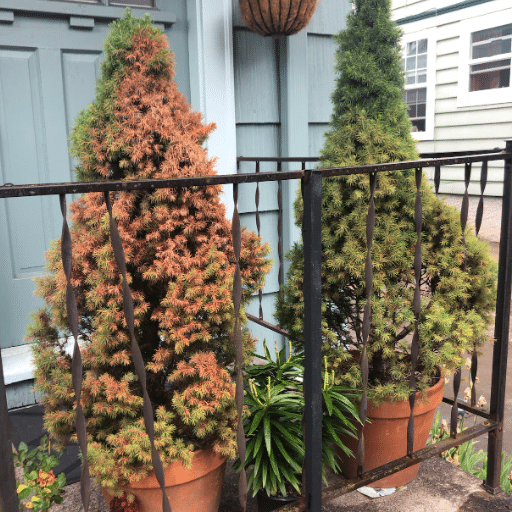
Take care of trees thrive in pots containers by making sure they receive plenty of sunlight and placing them where the ambient temperature fits their optimum requirements. The soil must be well-drained to protect the trees from being waterlogged; water the trees regularly but not unnecessarily, with good monitoring of moisture in the soil. Fertilize in the growing season with a balanced fertilizer to provide all the nutrients the trees require for growth, but do not overdo it, which may be detrimental to the plant. Prune as and when needed for shaping and to eliminate diseased or overcrowded branches. Finally, repot once every two or three years, as this refreshes the soil with nutrients and allows the roots to grow nicely, which are good for the trees on the whole.
Watering and Fertilization
In terms of watering, I try to keep the soil evenly moist but not soggy. This is because overwatering can result in root rot. An important step is to check the soil regularly, and when the upper inch feels dry, I water my plant well. Fertilizing during the growing season with a balanced, water-soluble fertilizer, usually once every month, ensures that it receives enough nutrients. Still, I want to avoid excessive fertilization as it could cause damage to my plant. This way, the tree stays healthy and starts growing adequately toward vigor.
Pruning and Maintenance
My pruning and maintenance involve just a few important steps. I prune in the dormant period, mostly in late winter, when I work on dead and damaged or diseased branches. It improves the look of the tree and will support healthier growth in return. I shall also thin the compact areas to provide better circulation of air and sunlight. During the year, I can monitor any new outbreaks or signs of pests or diseases and rectify the problem immediately so it cannot spread any further. Keeping a watchful eye on regular care guarantees that the tree stays healthy and keeps growing over time.
Managing Pests and Diseases
I submit myself to early diagnosis and prevention to control pests and diseases effectively. Constant inspections go to my trees upon all unusual signs, like discolored leaves, holes in the windfall, or sap leaks, which are direct warnings of some pest activities or diseases bothering my growing plants. Whenever an assignment pops up for intervention, I would mostly try to identify the exact kind of pest or disease so as to offer the best treatment option-either chemical or organic-given the circumstances. I tend to trust treatments that are ecologically friendly, such as insecticidal soap and neem oil, because the cure would not be detrimental to beneficial insects or the environment that I am trying to protect. Additionally, I take care of my trees through good soil management, proper pruning, and correct watering since a healthy tree will always better resist the invasion of pests and diseases.
Conclusion: Enjoying Your Container Garden
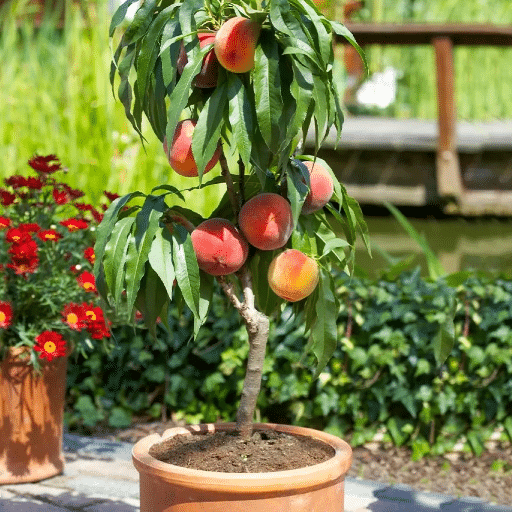
A thriving and aesthetically pleasing container garden can provide great gratification and joy. Proper care involves the choice of plants, the nurturing of the plants, and keeping abreast of possible troubles from pests or diseases. Using environmentally sound methods to enrich the soil will better support sustainable growth. Remember, your container garden is an expression of dedication and creativity: feel proud of the work and bask in the gratification it brings to your home and outdoor area.
Tips for a Successful Container Garden
Choose Suitable Containers and Soil: Containers that allow drainage are the best choice. The soil in containers should encourage good root growth and be of premium quality.
Sunlight and Watering: Providing plants with the appropriate amount of shade according to their needs is extremely important. Water plants regularly, but do not overwater.
Fertilize: Very often, slow-release fertilizers are the best option to give plants the nutrients needed to grow big and strong.
Pests and Diseases Monitoring: Check your plants very often to see if there has been an infestation or the appearance of a disease. Use only eco-friendly solutions to remove any interference or inconvenience.
Rotate and Seasonal Refresh: By changing plants with each season, your container garden will stay alive and bloom with all-around attraction.
Inspiring Container Garden Ideas
Really, the sky is the limit when it comes to container gardening! Here are some of my favorites to get you started.
Edible Container Gardens: Could a beautiful garden be more useful? Plant a mix of herbs, fruits, and vegetables: Consider throwing a few containers with cherry tomatoes, basil, or strawberries into the mix so you can enjoy fresh-from-the-garden ingredients.
Pollinator-Friendly Pots: Draw bees, butterflies, and other pollinators by planting flowers such as lavender, marigolds, or zinnias. Combine these plants to create a colorful and buzzing ecosystem.
Vertical Gardens for Small Spaces: Think vertical with wall planters, multi-tiered stands, or hanging baskets. This saves space and gives a dynamic flair to your garden.
Color-Coordinated Themes: Put together a stunning visual presentation with flowers grouped on color schemes with contrast or similarity. Proceed and try different textures and shapes for more dimension.
Succulent and Cactus Arrangements: These are good for beginners or those with less time. These drought-tolerant beauties thrive in just about any creative container you can dream up.
From edible to ornamental, container gardens provide unlimited ways to customize and beautify your space, be it a petite balcony or a sprawling patio!
Final Thoughts on Growing Trees in Pots
Growing trees in pots is a rewarding experience as it creates flexibility and beauty to your living space. From what I have seen, the secret lies in selecting a tree variety best suited for container life-it is best to go for dwarf or slow-growing types. Then, choose a large, stable pot with great drainage and with top-quality soil, giving your tree a great start. Regular watering, fertilizing, and some pruning are needed to keep the tree healthy. While you will face challenges, such as root crowding or temperature sensitivities, these can be minimized with some care and attention. In the end, potted trees can become an amazing solution for decorating an area and providing greenery in places where a conventional garden will not fit.
References
-
Jay Scotts Blog: A comprehensive guide on growing trees in pots, including a list of the best trees for large containers.
-
Epic Gardening: A detailed article listing 21 of the best trees for outdoor containers, including care tips and recommendations.
-
Portland Nursery: A resourceful guide on container trees, focusing on trees under 10 feet suitable for patios and small spaces.
Frequently Asked Questions (FAQ)
What are the best trees for growing in containers?
When considering the best trees for growing in containers, it’s essential to choose varieties that adapt well to restricted root space. Dwarf conifers, such as the dwarf Alberta spruce, are great options as they maintain a manageable size and provide year-round interest. Additionally, myrtles and smaller fruit trees like the lemon tree or peach tree can thrive in pots, offering both beauty and tasty fruit. It’s important to select a container size that allows for adequate root growth and to ensure plenty of drainage. Regularly checking the soil moisture will help your trees remain healthy and vibrant.
How can I grow a potted tree successfully?
Growing a potted tree successfully involves several key steps to ensure its health. First, choose a suitable pot that is large enough to accommodate the tree’s root system while allowing for growth. Consider using a high-quality potting mix that retains moisture but also allows for good drainage, as roots are confined in a container. Regular watering is crucial, especially in warmer months, to keep the tree hydrated. Additionally, placing the potted tree in a sunny spot or one that receives morning sun and afternoon shade can benefit its growth. Lastly, fertilizing during the growing season will help provide the necessary nutrients for your potted tree.
Can a Japanese maple thrive in a container?
Yes, a Japanese maple can thrive in a container, provided it receives the right care. These trees prefer partial shade and well-draining soil, making them suitable for container growth. When planting a Japanese maple in a pot, ensure that the container is large enough to support its root system and allows for sufficient drainage. Regular pruning and monitoring for pests are also important to maintain its health. Additionally, using a pot with a wide base can help prevent it from toppling over as the tree grows taller. With proper attention, a Japanese maple can add stunning curb appeal to any terrace or patio.
How do I care for a myrtle tree in a pot?
Caring for a myrtle tree in a pot requires specific attention to its watering and sunlight needs. Myrtles are known for their ability to thrive in containers, but they need enough sun and protection from harsh winters. Ensure that you place the pot in a location that receives full sun, and water the tree regularly to keep the soil consistently moist but not soggy. It’s also beneficial to use a larger container for more root space, especially as the tree matures. Fertilizing during the growing season can help promote vibrant foliage and flowering. Additionally, consider moving the pot to a sheltered area during extreme weather to protect the roots.
What container size is best for a peach tree?
The best container size for a peach tree depends on the specific variety you are growing, but generally, a large pot is recommended. A container with a diameter of at least 18-24 inches will provide ample space for the roots to grow and expand. Make sure the pot has plenty of drainage holes at the bottom to prevent waterlogging, which can harm the roots. When planting, use a high-quality potting mix that retains moisture while allowing for good drainage. Regular monitoring of soil moisture and fertilization during the growing season will help ensure a healthy peach tree that produces tasty fruit. As the tree grows, consider repotting it into a larger container to accommodate its expanding root system.

